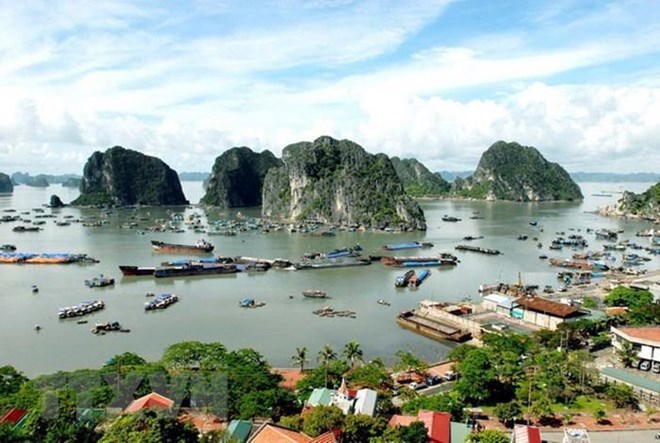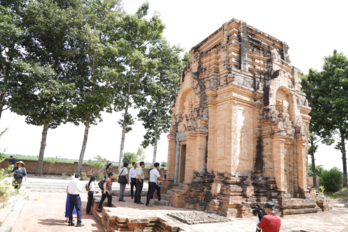
Ha Long Bay (Photo: VNA)
There are two cement plants very close to the bay in Hoanh Bo district – the Thang Long Cement Joint Stock Company plant with capacity of 2.3 million tonnes per year and the Ha Long Cement Joint Stock Company plant with an annual capacity of 2 million tonnes.
The dust and fume exhaust treatment systems of the plants meet current environmental regulations, but the dust they discharge has still worsened pollution in the protected area.
Provincial authorities fined the plants in 2011 and 2018 55 million VND and 290 million VND (2,375-12,500 USD), respectively.
Speaking at the meeting, Vice Chairman of the Quang Ninh People’s Committee Cao Tuong Huy proposed the Ministry of Transport report the case to Prime Minister Nguyen Xuan Phuc and exclude the two plants from the national cement development plan for the coming years.
In 2014, the Quang Ninh People’s Council decided not to build any new thermal power plants or cement plants within a radius of 15km around the heritage area.
On September 8, 2016, the provincial People’s Committee sent a proposal to the Ministry of Construction to stop increasing the capacity of present plants and move planned plants further away. Both moves were designed to protect the natural landscapes of the UNESCO site.
Chairman of the Quang Ninh People’s Council Nguyen Xuan Ky said that by 2030, all of the cement plants would be moved to more suitable places. Their current locations would be used to develop urban areas or environmentally friendly plants.
Deputy Prime Minister Trinh Dinh Dung recently signed Decision 702/QĐ-TTG to approve the plan for the city of Ha Long's development. The decision sets out a vision lasting until 2050.
Under the decision, it will be developed into a modern and friendly coastal tourism city. It must have modern infrastructures and conserve the world heritage site.
Ky instructed concerned organizations to protect the environment around the heritage area and asked them to send proposals to the State and the Government to create good conditions for the province to meet its green development targets.
Earlier in April this year, the International Union for Conservation of Nature (IUCN) held a workshop in Quang Ninh to seek technology and management solutions for wastewater treatment from tour boats and tourism activities in Ha Long Bay and Cat Ba Archipelago.
The workshop was part of the Ha Long Bay-Cat Ba Alliance Initiative, funded by the US Agency for International Cooperation (USAID).
According to deputy head of the Ha Long Bay Management Board Nguyen Huyen Anh, as of late 2018, there were around 500 ships operating in Ha Long Bay, including over 160 overnight ships, and 121 vessels operating around the Cat Ba archipelago, including 59 overnight boats.
In recent times, local authorities have made strides to tighten management over wastewater from tourism boats and activities. However, this kind of pollution remains a huge challenge for Quang Ninh and Hai Phong city, he said.
Jake Brunner, IUCN Chief Representative in Vietnam, said the IUCN sent an advisory mission to Ha Long Bay to support sustainable tourism management and environmental protection at Ha Long Bay and Cat Ba archipelago in July last year.
The advisory mission had expressed their concern over the projected growth of visitors to the site and concluded that ineffective management of visitors and waste will cause a significant threat to the outstanding universal value of the area, Brunner added.
Ha Long Bay literally “descending dragon bay” is a must-see destination in Quang Ninh. It was twice recognized as a UNESCO World Heritage Site in 1994 and 2000.
The bay spans 1,553 square kilometers and includes 1,969 islands of various sizes. It features thousands of limestone karsts and islets in various shapes and sizes. The limestone in the bay has gone through 500 million years of formation in different conditions and environments. The geo-diversity of the environment has created biodiversity, including a tropical evergreen biosystem, oceanic and sea biosystem. Ha Long Bay is home to 14 endemic floral species and 60 endemic faunal species.
This year, Ha Long Bay has been listed among the world’s most beautiful sunrise spots in 2019 by the Microsoft Network (MSN). It was also labelled as one of the most mentioned global cruise destinations on Instagram by British magazine Woman and Home; among the 25 most beautiful places around the world by the US’s Cable News Network (CNN), and among the most popular attractions in Asia according to the Hong Kong-based South China Morning Post (SCMP)./.
VNA
 Developing community tourism from heritage
Developing community tourism from heritage



